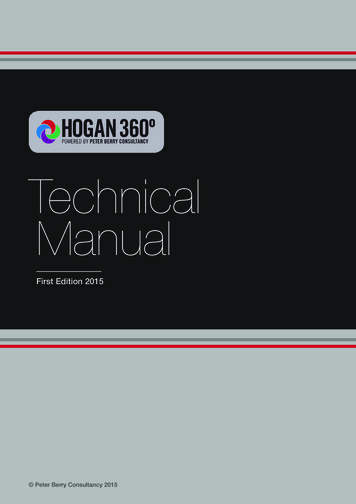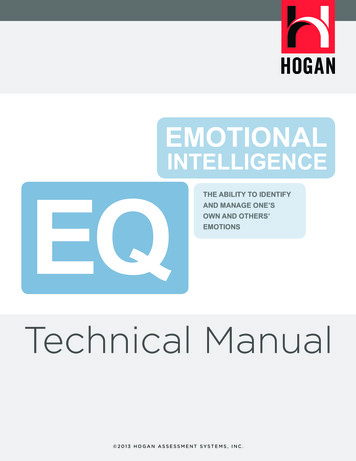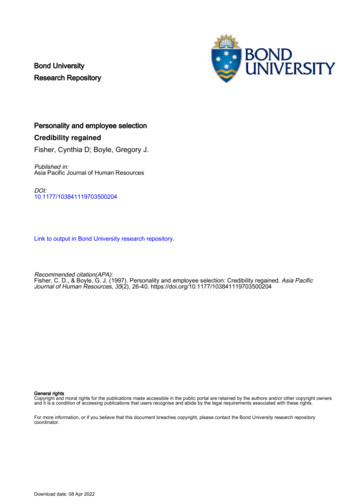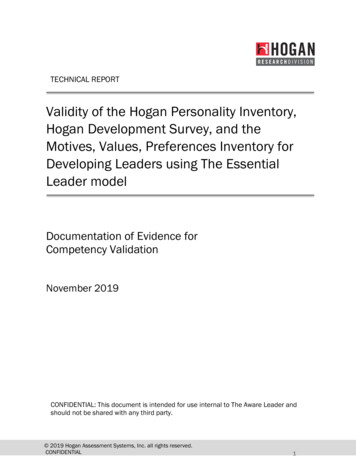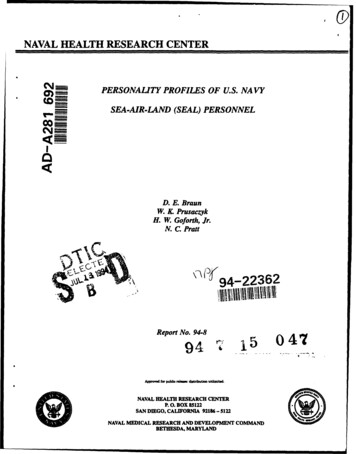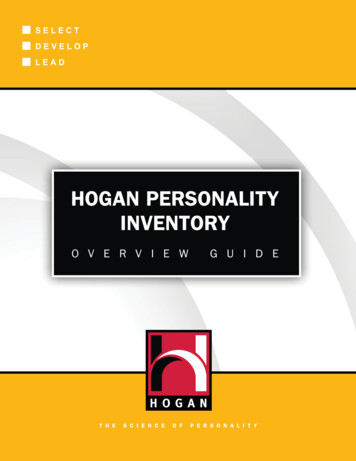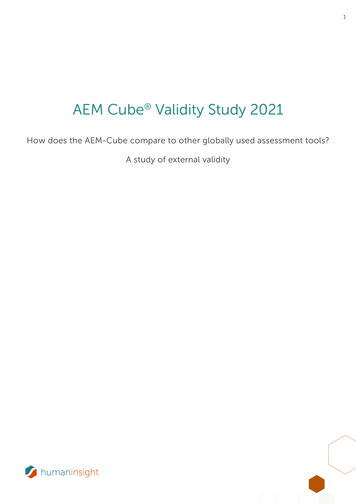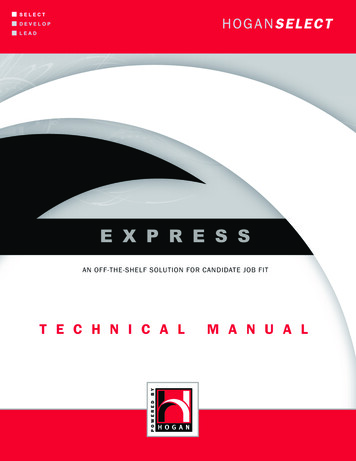
Transcription
Hogan Express ReportTechnical ManualHogan Assessment SystemsTulsa, OK 74114, USA2009
2009 Hogan Assessment SystemsNo part of this work may be copied or transferred to any other form or expressionwithout the expressed written consent from Hogan Assessment Systems, Inc.Hogan Personality Inventory Hogan Development Survey Motives, Values, Preferences Inventory are the exclusive registered trademarks ofHogan Assessment Systems, Inc.www.hoganpress.comFirst printing 06-09ISBN 978-0-9840969-0-9
EXECUTIVE SUMMARYEXECUTIVE SUMMARYThis document reviews the validity of personality measures for selecting employees in the following sevenjob families: Managers & Executives, Professionals, Technicians & Specialists, Sales & Customer Support, Administrative & Clerical, Operations & Trades, and Service & Support. The report reviews the procedures used to evaluate the validity of personality measures for predicting job performance within eachfamily. These methods included three types of validity generalization: meta-analysis, transportability, andsynthetic/job component validity.Specifically, validity generalization methods are used to identify scales from the Hogan Personality Inventory (HPI; R. Hogan & Hogan, 1995, 2007) that are significantly correlated with performance across and withinseven job families.According to the Uniform Guidelines on Employee Selection Procedures, when jobs are similar and theselection procedures are valid and fair, test validity from one job can be used for decision-making insimilar jobs. For each of the seven job families, transportability of validity evidence is based on datafrom multiple jobs in the Hogan Archive; job similarity was determined using job descriptions, previousjob analysis information, and Department of Labor and Occupational Information Network job codes. Theoriginal validation studies provide the predictor-criterion relations necessary to transport the HPI scales forfuture selection. Results from archival studies reveal that cutoff scores for the HPI can be used to predictperformance for each job family and will yield no adverse impact.Synthetic/job component validity involves: (a) defining critical job components or competencies for eachjob family through a review of job analysis information; (b) identifying valid predictors of those job components within archival studies; and (c) applying the results to the same components in each of the sevenjob families. Synthetic/job component validity evidence is an additional justification for using designatedHPI scales as a selection battery to predict job components required in each job family.Based on the job analysis results and validity generalization evidence, Hogan recommends a profile ofHPI scale scores for personnel selection in each job family. Simulations using an archival applicant poolindicate that the recommended cutoff scores are fair and should not result in adverse impact.1
TA B L E O F C O N T E N T SCONTENTS1. Introduction71.1 Overview71.2 User, Location(s), and Dates of Study81.3 Problem and Setting81.4 Job Families92. Description Of Predictors112.1 Approach and Rationale112.2 What to Measure and Why112.3 The Hogan Personality Inventory132.4 Hogan Personality Inventory Test Description and Development263. Inventory Construction, Reliability, And Confirmation193.1 Early Development193.2 Later Development203.3 Most Recent Technical Developments213.4 Definitions of the Scales223.5 Composition of the Personality Scales233.6 Composition of the Personality Scales: The 2007 Confirmatory Factor Analysis253.7 HPI Scale Distributions and Reliability303.8 HPI Test-Retest Reliability364. Generalizing Validity Evidence From The Five-factor Model And The HPI414.1 Meta-Analysis Results from Accumulated FFM Validity Studies424.2 Benchmarking Validity Coefficients444.3 Meta-Analysis Summary for FFM and HPI Validity Studies464.4 Transportability of Validity Evidence464.5 Synthetic Validity/Job Component Validity472
TA B L E O F C O N T E N T S5. Validity Generalization Results For Job Families495.1 Managers & Executives Job Family495.2 Professionals Job Family555.3 Technicians & Specialists Job Family615.4 Operations & Trades Job Family665.5 Sales & Customer Support Job Family705.6 Administrative & Clerical Job Family765.7 Service & Support Job Family816. Norms, Uses, And Applications866.1 Characteristics of the 2005 HPI Norming Sample866.2 Demographics of the Norming Sample916.3 Demographics of the Norming Sample926.4 Uses and Applications976.5 Accuracy and Completeness977. References99Appendix A: O*NET Job Titles Classified By Job Family109Appendix B: Recommended Process Steps For Job FamilyClassification And Implementation115Appendix C: Distribution Of Scales For The 2005 HPI Normative Sample (N 156, 614)116Appendix D: References For Transportability Of Validity Within Job Families1173
TA B L E S & F I G U R E STABLES & FIGURESTable 1.1US Department of Labor Job Categories and SOC Codes Categorized by Job Family10Table 2.1Correlations Between Goldberg’s Big-Five Markers and the HPI Scale13Table 2.2Correlations Between the PCI Primary Scales and the HPI Scales13Table 2.3Correlations Between the Inventario de Personalidad de Cinco Factores (IP/5F) and the HPIScales14Table 2.4Correlations Between the NEO-PI-R and the HPI Scales14Figure 2.1Relations Between FFM Inventories and Primary HPI Scales15Table 3.1The Constituent HICs for the Seven HPI Scales24Table 3.2Intercorrelations Between HPI Observed Scale Scores and Latent Factor Scores26Figure 3.1HIC-Level Confirmatory Factor Model for the HPI27Figure 3.2Histogram of Standardized Residuals for the Oblique Factor Model with Maximum LikelihoodParameter Estimation28Table 3.3CFA factor Loadings for the HPI HICs29Table 3.4Classical Item and Scale Statistics for the HPI34Table 3.5Composite Alphas and Standard Errors of Measurement for the Seven HPI Scales35Table 3.6Hypothetical Scores on a Personality Scale over Two Test Occasions36Figure 3.3Hypothetical Scores and Test-Retest Reliabilities for a Personality Scale over Two TestOccasions37Table 3.7Short-Term (14-21 day interval) Test-Retest Stability Indices for the HPI39Table 3.8Long-Term (8 years interval) Test-Retest Stability Indices for the HPI40Table 4.1FFM Personality Scale Meta-Analysis Results – Uncorrected Validity Estimates43Table 4.2Meta-Analysis Results for HPI Scales with Construct-Aligned Criteria43Table 4.3Comparative Validity of Assessments for Predicting Overall Job Performance45Table 5.1Managers & Executives Jobs with Criterion-Related Data for Transportability of Validity50Table 5.2Meta-Analytic Correlations between HPI Scales and Performance Criteria for Managers &Executives Jobs51Table 5.3HPI Scale Synthetic Validity/Job Component Validity for Managers & Executives Job FamilyCompetencies53Table 5.4Recommended Cutoff Scores for Managers & Executives Jobs54Table 5.5Selection Rates and Adverse Impact for Managers & Executives Jobs Using RecommendedCutoff Scores54Table 5.6Recommended Pass-Plus Cutoff Scores for Managers & Executives Jobs55Table 5.7Professionals Jobs with Criterion-Related Data for Transportability of Validity57Table 5.8Meta-Analytic Correlations between HPI Scales and Performance Criteria for Professionals Jobs57Table 5.9HPI Scale Synthetic Validity/Job Component Validity for ProfessionalsJob Family Competencies58Table 5.10Recommended Cutoff Scores for Professionals Jobs59Table 5.11Selection Rates and Adverse Impact for Professionals Jobs Using Recommended Cutoff Scores60Table 5.12Recommended Pass-Plus Cutoff Scores for Professionals Jobs60Table 5.13Technicians & Specialists Jobs with Criterion-Related Data for Transportability of Validity62Table 5.14Meta-Analytic Correlations between HPI Scales and Performance Criteria for Technicians &Specialists Jobs624
TA B L E S & F I G U R E STable 5.15HPI Scale Synthetic Validity/Job Component Validity for Technicians & Specialists Job FamilyCompetencies63Table 5.16Recommended Cutoff Scores for Technicians & Specialists Jobs64Table 5.17Selection Rates and Adverse Impact for Technicians & Specialists Jobs Using RecommendedCutoff Scores65Table 5.18Recommended Pass-Plus Cutoff Scores for Technicians & Specialists Jobs65Table 5.19Operations & Trade Jobs with Criterion-Related Data for Transportability of Validity67Table 5.20Meta-Analytic Correlations between HPI Scales and Performance Criteria for Operations &Trades Jobs67Table 5.21HPI Synthetic Validity/Job Component Validity for Operations & TradesJob Family Competencies68Table 5.22Recommended Cutoff Scores for Operations & Trades Jobs69Table 5.23Selection Rates & Adverse Impact for Operations & Trades Jobs Using Recommended CutoffScores70Table 5.24Recommended Pass-Plus Cutoff Scores for Operations & Trades Jobs70Table 5.25Sales & Customer Support Jobs with Criterion-Related Data for Transportability of Validity72Table 5.26Meta-Analytic Correlations between HPI Scales and Performance Criteria for Sales & CustomerSupport Jobs73Table 5.27HPI Synthetic Validity/Job Component Validity for Sales & Customer Support Job FamilyCompetencies74Table 5.28Recommended Cutoff Scores for Sales & Customer Support Jobs75Table 5.29Selection Rates & Adverse Impact for Sales & Customer Support Jobs Using RecommendedCutoff Scores76Table 5.30Recommended Pass-Plus Cutoff Scores for Sales & Customer Support Jobs76Table 5.31Administrative & Clerical Jobs with Criterion-Related Data for Transportability of Validity77Table 5.32Meta-Analytic Correlations between HPI Scales and Performance Criteria for Administrative &Clerical Jobs78Table 5.33HPI Synthetic Validity/Job Component Validity for Administrative & Clerical Job FamilyCompetencies79Table 5.34Recommended Cutoff Scores for Administrative & Clerical Jobs80Table 5.35Selection Rates and Adverse Impact for Administrative & Clerical Jobs Using RecommendedCutoff Scores80Table 5.36Recommended Pass-Plus Cutoff Scores for Administrative & Clerical Jobs81Table 5.37Service & Support Jobs with Criterion-Related Data for Transportability of Validity82Table 5.38Meta-Analytic Correlations between HPI Scales and Performance Criteria for Service & SupportJobs82Table 5.39HPI Synthetic Validity/Job Component Validity for Service & SupportJob Family Competencies83Table 5.40Recommended Cutoff Scores for Service & Support Jobs84Table 5.41Selection Rates and Adverse Impact for Service & Support Jobs Using Recommended CutoffScores85Table 5.42Recommended Pass-Plus Cutoff Scores for Service & Support Jobs85Table 6.1HPI Database Classified by DoL Occupations88Table 6.2HPI Norming Sample Distribution by Occupation Using Applicants in Selection Contexts89Table 6.3Final Norming Sample Distribution by Test Purpose90Table 6.4Final Norming Sample Distribution by Occupation90Table 6.5Gender Distribution of Final Norming Sample915
TA B L E S & F I G U R E STable 6.6Race/Ethnicity Distribution of Final Norming Samplle91Table 6.7Norming Sample Ethnic Composition by Age and Gender91Table 6.8Norming Sample Scale Means and Standard Deviations92Table 6.9Norming Sample Scale Means and Standard Deviations by Age93Table 6.10Norming Sample Scale Means and Standard Deviations by Gender94Table 6.11Norming Sample Scale Means and Standard Deviations by Age and Gender95Table A.1Managers & Executives O*NET SOC Codes and Job Titles109Table A.2Professionals O*NET SOC Codes and Job Titles109Table A.3Technicians & Specialists O*NET SOC Codes and Job Titles111Table A.4Operations & Trades O*NET SOC Codes and Job Titles112Table A.5Sales & Customer Support O*NET SOC Codes and Job Titles113Table A.6Administrative & Clerical O*NET SOC Codes and Job Titles113Table A.7Service & Support O*NET SOC Codes and Job Titles1136
1. INTRODUCTION1. INTRODUCTIONHogan Assessment Systems (Hogan) is the publisher of personality assessments that evaluate a candidate’s fit with a job. Hogan provides comprehensive employee selection and development systems forcustomers throughout the United States and around the world. Hogan is the industry leader for real timepersonality assessment and reporting.This report presents a technical summary of research evaluating the validity of the Hogan PersonalityInventory (HPI) for selecting individuals into seven job families: Managers & Executives, Professionals,Technicians & Specialists, Operations & Trades, Sales & Customer Support, Administrative & Clerical, andService & Support. Based on over two decades of research on the validity of personality scales for predicting job performance across jobs and organizations, Hogan has identified profiles that can inform theselection of high potential individuals for all major job families in mid-sized organizations.The research presented in this report conforms to the standards of the Uniform Guidelines on EmployeeSelection Procedures (Equal Employment Opportunity Commission, Civil Service Commission, Department of Labor, & Department of Justice, 1978; hereafter “Uniform Guidelines”)and The Principles for the Validation and Use of PersonnelSelection Procedures (Society for Industrial and Organizational Psychology, 2003; hereafter “Principles”). In areas wherethe Uniform Guidelines and/or Principles lack specificity, the research approach relies on the broaderscientific/professional literature for guidance.1.1 OverviewThe research by Hogan sought to identify valid personality measures useful for predicting performancein jobs within each of seven job families. This document is organized around Section 15 of the UniformGuidelines and technical information is contained in the following sections: Introduction – a brief overview of the job families research project Description of Predictors – a history and review of the HPI Inventory Construction, Reliability, and Confirmation – psychometric information Generalizing Validity Evidence from the Five-Factor Model and the HPI – a review of meta-analysisliterature Validity Generalization Results for Job Families – a review of evidence supporting the use of the HPI forseven job families Norms, Uses, and Applications – describes the normative percentile scoring system and application ofthe selection procedure7
1. INTRODUCTION1.2 User, Location(s), and Dates of StudyHogan initiated efforts to identify valid scales and standardized cutoff scores for the HPI’s use with jobfamilies in April 2004. Hogan finalized job family descriptions in June 2004, and completed the validitygeneralization procedures outlined in this report, along with final cutoff score recommendations in March2006. All validation research contained in the Hogan archives that is used for this study was conducted inthe United States between 1982 and 2005.1.3 Problem and SettingA review of the Hogan job families indicates personality measures would be useful additions as predictorsof job performance. The problem is to identify valid personality profiles specifically for seven job families that are appropriate for personnel selection. The desired selection components include: (a) reliablemeasurement [personality scales show internal item consistency and stability over time]; (b) evidence thatpersonality scores predict meaningful non-test behavior, documented in credible sources; (c) personalityscales that predict relevant job component criteria; and (d) personality measurement that does not discriminate unfairly on the basis of age, gender, or race/ethnicity.Hogan evaluated the validity of the HPI (R. Hogan & Hogan, 1995, 2007) for performance prediction in each jobfamily based on evidence that personality measures predict critical competencies for these jobs (Hogan& Holland, 2003).The research setting to access technical validation studies was the Hogan archives andthe HPI data warehouse. Prior to 2001, HPI data in the archive were machine scored using computerizedscoring software. In May 2001, HPI data collection began using the Web-based Assessment Management(WAM) system, which produces a scored database from internet administration of the HPI. WAM’s successor is HALO, Hogan Assessments Link Online, which is a secure online platform for administering assessments and managing client applications. For the current application, no previous selection procedures orcutoff scores were specified by Hogan.The scope of the research is defined by the job families. The personality assessments specified for eachjob family are intended to be used with candidates who apply for jobs classified within a job family. Noassessment distinctions are made for the variety of jobs included in a job family. This is a limitation ofthe research because subtle differences between jobs within a family are not reflected in the selectionsystem. Hogan recommends local validation, where feasible, to specify more precise selection solutionsfor use in individual jobs.8
1. INTRODUCTION1.4 Job FamiliesJob families are groups of occupations classified as similar based on work performed, skills, education,training, and credentials required for competence. The seven job families identified for this project werederived by Hogan from nine “job classifications” used by the Equal Employment Opportunity Commission(EEO) for employers in the United States. These nine EEO job classifications capture information to tabulate an organization’s ethnic make-up. This scheme is used by Hogan for two reasons: (a) a large percentage of employers within the United States are familiar with the EEO job classifications; and (b) the jobclassifications are conceptually clear and easy to use for reporting purposes.Based on prior experience with competencies, Hogan determined that the same competency models couldbe used for the original EEO job classifications of Craft Worker, Operative, and Laborer. Each of these jobclassifications are combined into the Operations & Trades job family used for this project. Hogan madeadditional modifications to job family names for the purpose of creating a less bureaucratic, more inclusivescheme of titles.Table 1.1 presents the seven job families along with the Hogan descriptions of those families, the USDepartment of Labor (DoL) classifications (US DoL, 2001), and the corresponding Occupational InformationNetwork (O*NET OnLine, 2005) job categories. The DoL Standard Occupational Classification (SOC) Systemwas developed by the US DoL in response to a growing need for a universal occupational classification system(US DoL, 1991).The SOC System contains 22 occupational categories that are used to classify all jobswithin the US workforce. The O*NET is the product of a large-scale effort to transfer SOC information to asearchable, web-based platform (Dye & Silver, 1999). For determining jobs within families, Tables A.1 thoughA.7 in Appendix A present O*NET job titles classified by job family. For further guidance on selecting theappropriate job family for a given job, see Appendix B.9
1. INTRODUCTIONTable 1.1US Department of Labor Job Categories and SOC Codes Categorized by Job FamilyJob FamiliesDefinitionsO*NET & SOC Job CategoriesManagers & ExecutivesEmployees assigned to positions of administrative or managerial authority over the human, physical, and financial resources of theorganization.ManagementProfessionalsEmployees with little legitimate authority, buthigh status within the organization becauseof the knowledge and/or skills they possess.These employees usually are experts with abroad educational background and rely primarily on their knowledge and intellect to performtheir duties.Architecture and EngineeringArt, Design, Entertainment, Sports,and MediaBusiness and Financial OperationsCommunity and Social ServiceEducation, Training, and LibraryHealth Practitioner and TechnicalLegalLife, Physical, and Social ScienceTechnicians & SpecialistsEmployees who rely on the application ofhighly specific knowledge in skilled manipulation (e.g., operation, repair, cleaning, and/orpreparation) of specialized technology, tools,and/or machinery. Computer and Mathematical ScienceInstallation, Maintenance, and RepairOperations & TradesCraft workers (skilled), operatives (semiskilled), and laborers (unskilled) whose jobknowledge and skills are primarily gainedthrough on-the-job training and experience;little prerequisite knowledge or skill is needed.Building and Grounds Cleaning andMaintenanceConstruction and ExtractionFarming, Fishing, and ForestryMilitary Specific ProductionTransportation and Material MovingSales and RelatedSales & Customer SupportEmployees who use appropriate interpersonalstyle and communication techniques to establish relationships, sell products or servicesthat fulfill customers’ needs, and providecourteous and helpful service to customersafter the sale.Administrative & ClericalEmployees who plan, direct, or coordinate sup- Healthcare Supportportive services of an organization. The mainfunction of these employees is to facilitate thefunction of professionals by completing jobsOffice and Administrative Supportthat require little formal education or skill tocomplete (e.g., professional assistants, secretaries, and clerks).Service & SupportEmployees that perform protective servicesfor individuals and communities (e.g., police, fire fighters, guards) and non-protectiveservices for individuals that require little to noformal training but a high degree of interactionwith people (e.g., food service, recreation andamusement).Food Preparation and ServingRelatedPersonal Care and ServiceProtective Service10
2. DESCRIPTION OF PREDICTORS2 - DESCRIPTION OF PREDICTORS2.1 Approach and RationaleValidating selection instruments relies on accurate measurement. Measurement can be defined as anyprocedure that assigns numbers systematically to characteristic features of people according to explicitrules (Ghiselli, Campbell, & Zedeck, 1981). These numbers are used to make predictions or forecast futurebehavior(s).Assigning numbers to characteristics is a critical, but not sufficient, requirement of any pre-employmentselection tool. Every selection tool should have available evidence to support: (a) the reliability of the instrument; and (b) the relations between scores on the instrument and job-relevant behaviors or outcomes(Equal Employment Opportunity Commission, et al., 1978).At a minimum, the reliability of pre-employment assess-ments should be evaluated in terms of the degree to which: (a) items or questions on a scale relate toone another (internal item consistency); and (b) results or scores remain stable over time (test-retestreliability).The ability of a pre-employment instrument to predict job-relevant outcomes should be available in crediblescientific sources. The supporting evidence should include significant and interpretable relations betweenscores on the pre-employment instrument and indices of job performance. Moreover, evidence shouldalso demonstrate that scores on the pre-employment instrument predict job performance criteria critical tosuccess in the job of interest, rather than an ability to predict performance outcomes that are unrelated tocritical work or behaviors.Pre-employment instruments should not discriminate unfairly on the basis of age, gender, or race/ethnicity(Equal Employment Opportunity Commission, et al., 1978).Selection procedures that result in adverse impact mustbe validated in accordance with the Uniform Guidelines. Unfortunately, many instruments currently usedin pre-employment screening processes fail to meet the criteria outlined above (R. Hogan, Hogan, & Trickey,1999).2.2 What to Measure and WhyBased on Hogan’s goal to evaluate the validity of personality measures for each job family, the followingsummarizes the measurement issues that influence personality assessment. The most important question is “What should we measure?” Historically, the answer depended on a test author’s personal interests (e.g., Locus of Control; Rotter, 1966), practical concerns (e.g., Minnesota Multiphasic Personality Inventory; Hathaway &McKinley, 1943),or theory (e.g., Myers-Briggs Type Indicator ; Myers, McCaulley, Quenk, & Hammer, 1998; Thematic Appercep-tion Test; Morgan & Murray, 1935).Multi-dimensional personality inventories developed during the 1940s and1950s measured traits (cf. Allport, 1937). Early approaches to personality inventory construction led to more11
2. DESCRIPTION OF PREDICTORSadvanced test development strategies and improved the quality and interpretability of the instruments.Current thinking in personality assessment converges on the idea that most personality characteristicscan be described in terms of five personality dimensions. The Five-Factor Model (FFM; cf. De Raad & Perugini,2002; Digman, 1990; Goldberg, 1992; John, 1990, p. 72; McCrae & Costa, 1987),which emerged from fifty years offactor analytic research on the structure of observer ratings (cf. Norman, 1963; Thurstone, 1934; Tupes & Christal,1961),suggests that we think about and describe others and ourselves (Goldberg, 1990) in terms of fivethemes:I. Surgency/Extraversion - the degree to which a person is outgoing and talkative.II. Agreeableness - the degree to which a person is rewarding to deal with and pleasant.III. Conscientiousness - the degree to which a person complies with rules, norms, and standards.IV. Emotional Stability - the degree to which a person appears calm and self-accepting.V. Intellect/Openness to Experience - the degree to which a person seems creative and open-minded.The FFM was the starting point for several personality inventories constructed over the last twenty years(e.g., NEO-PI: Costa & McCrae, 1985; HPI: R. Hogan & Hogan, 1995, 2007; Personal Characteristics Inventory: Mount & Barrick,2001).The five dimensions provide a useful taxonomy for classifying individual differences in social be-havior (i.e., reputation). Evidence suggests that all existing multidimensional personality inventories mapthese five dimensions to a greater or lesser extent (De Raad & Perugini, 2002; Wiggins & Pincus, 1992). Consequently, the FFM is the paradigm for current research in personality assessment (De Raad & Perugini, 2002; R.Hogan & Hogan, 1995, 2007).The FFM is based on observers’ descriptions of others, which form the basis for one’s reputation – i.e.,how people describe coworkers or peers (Hogan, 1983). Reputations grow from social consensus regardingconsistencies in a person’s behavior, and develop from behavior during social and occupational interaction. These behaviors consist, at least in part, of actions designed to establish, defend, or enhancethat person’s identity – i.e., a person’s view of him or herself (cf. Goffman, 1958). Reputations are public,tell us about observable tendencies in the others’ behaviors, can be measured reliably, and can be usedto forecast future behavior (cf. Emler, 1990; Ozer & Benet-Martinez, 2006). A person’s reputation represents aninvaluable source of information about work-related strengths and shortcomings, and it also influences thedirection of careers.Personality assessment samples self-presentational behavior – i.e., how a person portrays him or herselfto others on the job. An assessment instrument allows us to aggregate these behavioral samples, assignthem numbers according to certain agreed-upon rules, and then use these numbers or scores to makepredictions about a person’s future behavior.12
2. DESCRIPTION OF PREDICTORS2.3 The Hogan Personality InventoryThe HPI was the first measure of normal personality developed explicitly to assess the FFM in occupationalsettings. The measurement goal of the HPI is to predict real-world outcomes. As such, it is an originaland well-known measure of the FFM and is considered a marker instrument, not only in English, but forpersonality measures in other languages as well. Tables 2.1 through 2.4 present correlations betweenthe HPI and other FFM assessments. Figure 2.1 shows median correlation coefficients that summarizeHPI relations with Goldberg’s (1992) Big-Five Markers (R. Hogan & Hogan, 1995), the Personal Characteristics Inventory (Mount & Barrick, 2001), the Inventario de Personalidad de Cinco Factores (Salgado & Moscoso, 1999), andthe NEO PI-R (Goldberg, 2000). Correlations range as follows: Adjustment/EmotionalStability/Neuroticism(.66 to .81); Ambition/Extraversion/Surgency (.39 to .60) Sociability/Extraversion/Surgency (.44 to .64);Interpersonal Sensitivity/Agreeableness (.22 to .61); Prudence/Conscientiousness (.36 to .59) Inquisitive/Openness/Intellect (.33 to .69); and Learning Approach/Openness/Intellect (.05 to .35).Table 2.1Correlations Between Goldberg’s Big-Five Markers and the HPI ScalesScaleADJAMBSOCINPPRUINQLRNFactor I - Surgency.04.55**-.03.31***-.24**.44***.29***Factor II Agreeableness.13-.11-.17*.56***.23**.02-.12Factor III *Factor IV Emotional Stability.70***.39***.11.27***.01-.04.28***Factor V – Intellect.05.22**.35***-.01.03-.04.33***Note. N 168. Table taken from the HPI Manual (R. Hogan & Hogan, 1995); ADJ Adjustment; AMB Ambition; INQ Inquisitive; INP Interpersonal Sensitivity; PRU Prudence; LRN Learning Approach; SOC Sociability. *p .05 ** p .01 ***p .001, one-tailed; directional relationships hypothesized a priori.Table 2.2Correlations Between the PCI Primary Scales and the HPI e. N 154; ADJ Adjustment; AMB Ambition; INQ Inquisitive; INP Interpersonal Sensitivity; PRU Prudence; SOC Sociability. *p .01.13
2. DESCRIPTION OF PREDICTORSTable 2.3Correlations Between the Inventario de Personalidad de Cinco Factores (IP/5F) and the HPI 31-.32-.26Openness.11.44.51.25-.15.69Note. N 200; Critical probability values were not provided in the study. ADJ Adjustment; AMB A
Specifically, validity generalization methods are used to identify scales from the Hogan Personality Inven-tory (HPI; R. Hogan & Hogan, 1995, 2007) that are significantly correlated with performance across and within seven job families. According to the Uniform Guidelines on Emp
